Blog & Latest Updates
Fly Fishing Articles
Insects by Common Name


Arthropod Class Insecta (Insects)
Taxonomic Navigation -?-
1 order isn't included.
Common Name
| Match | Common Name |
| Insects |
This is page 11 of specimens of Insecta. Visit the main Insecta page for:
- The behavior and habitat of Insecta.
- 114 underwater pictures of Insecta.
Pictures of 1229 Insect Specimens:
Isonychia bicolor (Mahogany Dun) Mayfly Nymph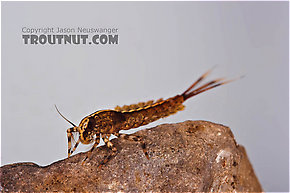 View 7 PicturesThis Isonychia bicolor nymph from the Catskills displays the prominent white stripe sometimes characteristic of its species. This is the first such specimen I've photographed, because members of the same species in the Upper Midwest have a more subdued stripe (and were once thought to be a different species, Isonychia sadleri). The striking coloration on this eastern nymph is more appealing.
View 7 PicturesThis Isonychia bicolor nymph from the Catskills displays the prominent white stripe sometimes characteristic of its species. This is the first such specimen I've photographed, because members of the same species in the Upper Midwest have a more subdued stripe (and were once thought to be a different species, Isonychia sadleri). The striking coloration on this eastern nymph is more appealing.
 View 7 PicturesThis Isonychia bicolor nymph from the Catskills displays the prominent white stripe sometimes characteristic of its species. This is the first such specimen I've photographed, because members of the same species in the Upper Midwest have a more subdued stripe (and were once thought to be a different species, Isonychia sadleri). The striking coloration on this eastern nymph is more appealing.
View 7 PicturesThis Isonychia bicolor nymph from the Catskills displays the prominent white stripe sometimes characteristic of its species. This is the first such specimen I've photographed, because members of the same species in the Upper Midwest have a more subdued stripe (and were once thought to be a different species, Isonychia sadleri). The striking coloration on this eastern nymph is more appealing.Collected April 19, 2006 from the Beaverkill River in New York
Added to Troutnut.com by Troutnut on April 21, 2006
Added to Troutnut.com by Troutnut on April 21, 2006
Maccaffertium ithaca (Light Cahill) Mayfly Nymph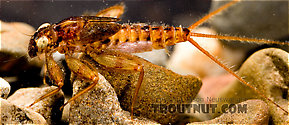 View 9 PicturesThis specimen seems to be of the same species as a dun I photographed which emerged from another nymph in the same sample.
View 9 PicturesThis specimen seems to be of the same species as a dun I photographed which emerged from another nymph in the same sample.
 View 9 PicturesThis specimen seems to be of the same species as a dun I photographed which emerged from another nymph in the same sample.
View 9 PicturesThis specimen seems to be of the same species as a dun I photographed which emerged from another nymph in the same sample.Collected May 29, 2007 from Paradise Creek in Pennsylvania
Added to Troutnut.com by Troutnut on June 4, 2007
Added to Troutnut.com by Troutnut on June 4, 2007
Hexagenia limbata (Hex) Mayfly Nymph View 7 Pictures
View 7 Pictures
 View 7 Pictures
View 7 PicturesCollected March 1, 2004 from unknown in Wisconsin
Added to Troutnut.com by Troutnut on January 25, 2006
Added to Troutnut.com by Troutnut on January 25, 2006
Isoperla (Stripetails and Yellow Stones) Stonefly Adult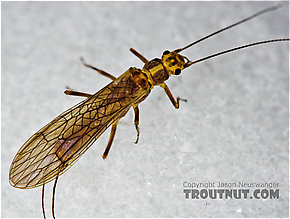 View 10 PicturesSeveral stoneflies of this species were flying around a small stream last night. I tied on a brown drake imitation of about the right size/color to approximate these stones, and was rewarded with a hard-fighting 17-inch brown trout.
View 10 PicturesSeveral stoneflies of this species were flying around a small stream last night. I tied on a brown drake imitation of about the right size/color to approximate these stones, and was rewarded with a hard-fighting 17-inch brown trout.
 View 10 PicturesSeveral stoneflies of this species were flying around a small stream last night. I tied on a brown drake imitation of about the right size/color to approximate these stones, and was rewarded with a hard-fighting 17-inch brown trout.
View 10 PicturesSeveral stoneflies of this species were flying around a small stream last night. I tied on a brown drake imitation of about the right size/color to approximate these stones, and was rewarded with a hard-fighting 17-inch brown trout.Collected July 7, 2006 from Cayuta Creek in New York
Added to Troutnut.com by Troutnut on July 8, 2006
Added to Troutnut.com by Troutnut on July 8, 2006
Taeniopterygidae (Willowflies) Stonefly Adult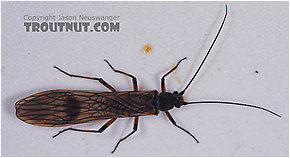 View 7 Pictures
View 7 Pictures
 View 7 Pictures
View 7 PicturesCollected March 29, 2005 from Salmon Creek in New York
Added to Troutnut.com by Troutnut on April 7, 2006
Added to Troutnut.com by Troutnut on April 7, 2006
Paragnetina immarginata (Beautiful Stonefly) Stonefly Adult View 9 Pictures
View 9 Pictures
 View 9 Pictures
View 9 PicturesCollected May 29, 2007 from Brodhead Creek in Pennsylvania
Added to Troutnut.com by Troutnut on June 4, 2007
Added to Troutnut.com by Troutnut on June 4, 2007
Maccaffertium ithaca (Light Cahill) Mayfly Dun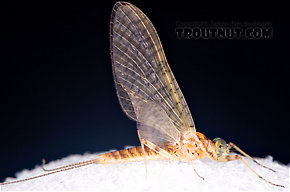 View 9 PicturesThis dun emerged from a nymph in one of the bowls on my table while I was sorting. I photographed it with the nymphal shuck (
View 9 PicturesThis dun emerged from a nymph in one of the bowls on my table while I was sorting. I photographed it with the nymphal shuck (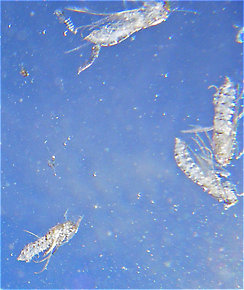 Shuck: The shed exoskeleton left over when an insect molts into its next stage or instar. Most often it describes the last nymphal or pupal skin exited during emergence into a winged adult.), and it seems to be of the same species as a nymph I photographed from the same sample.
Shuck: The shed exoskeleton left over when an insect molts into its next stage or instar. Most often it describes the last nymphal or pupal skin exited during emergence into a winged adult.), and it seems to be of the same species as a nymph I photographed from the same sample.
 View 9 PicturesThis dun emerged from a nymph in one of the bowls on my table while I was sorting. I photographed it with the nymphal shuck (
View 9 PicturesThis dun emerged from a nymph in one of the bowls on my table while I was sorting. I photographed it with the nymphal shuck (
Here's an underwater view of the pupal shucks of several already-emerged Brachycentrus numerosus caddisflies.
Collected May 29, 2007 from Paradise Creek in Pennsylvania
Added to Troutnut.com by Troutnut on June 4, 2007
Added to Troutnut.com by Troutnut on June 4, 2007
Female Baetidae (Blue-Winged Olives) Mayfly Spinner View 12 PicturesThis species is probably in Centroptilum, Cloeon, or Procloeon. I captured this spinner on the same night as a dun which is probably of the same species.
View 12 PicturesThis species is probably in Centroptilum, Cloeon, or Procloeon. I captured this spinner on the same night as a dun which is probably of the same species.
 View 12 PicturesThis species is probably in Centroptilum, Cloeon, or Procloeon. I captured this spinner on the same night as a dun which is probably of the same species.
View 12 PicturesThis species is probably in Centroptilum, Cloeon, or Procloeon. I captured this spinner on the same night as a dun which is probably of the same species.Collected August 9, 2006 from the West Branch of Owego Creek in New York
Added to Troutnut.com by Troutnut on August 11, 2006
Added to Troutnut.com by Troutnut on August 11, 2006
Hydropsyche (Spotted Sedges) Caddisfly Pupa View 8 PicturesSeveral users have interesting comments in the discussion of this specimen, but this observation by Creno is especially good:
View 8 PicturesSeveral users have interesting comments in the discussion of this specimen, but this observation by Creno is especially good:
 View 8 PicturesSeveral users have interesting comments in the discussion of this specimen, but this observation by Creno is especially good:
View 8 PicturesSeveral users have interesting comments in the discussion of this specimen, but this observation by Creno is especially good:Also, this is what I would call an "immature" pupa. The wingpads of caddis pupae darken to nearly black as the enclosed adults near emerging. The darkening is the developing adult wing inside the pupal wing pad (Wing pad: A protrusion from the thorax of an insect nymph which holds the developing wings. Black wing pads usually indicate that the nymph is nearly ready to emerge into an adult.). The ultimate coloration of the adult wing is not very apparent in most pupal wing pads ( The wing pads on this final instar Baetidae mayfly nymph are extremely dark.Wing pad: A protrusion from the thorax of an insect nymph which holds the developing wings. Black wing pads usually indicate that the nymph is nearly ready to emerge into an adult.) as the majority of the adult wing coloration comes from the color/position of the adult wing hairs and setae (Seta: Little hairs on insects.). But dark pupal wingpads are a good indication that the emergence will occur very soon, likely that day or so, and that the adult parts are sufficiently developed within the pupae to make a species determination from the specimen, particularly if it is a male.
The wing pads on this final instar Baetidae mayfly nymph are extremely dark.Wing pad: A protrusion from the thorax of an insect nymph which holds the developing wings. Black wing pads usually indicate that the nymph is nearly ready to emerge into an adult.) as the majority of the adult wing coloration comes from the color/position of the adult wing hairs and setae (Seta: Little hairs on insects.). But dark pupal wingpads are a good indication that the emergence will occur very soon, likely that day or so, and that the adult parts are sufficiently developed within the pupae to make a species determination from the specimen, particularly if it is a male. The wing pads on this final instar Baetidae mayfly nymph are extremely dark.
The wing pads on this final instar Baetidae mayfly nymph are extremely dark.
Collected May 13, 2007 from the Delaware River in New York
Added to Troutnut.com by Troutnut on May 18, 2007
Added to Troutnut.com by Troutnut on May 18, 2007
Eurylophella temporalis (Chocolate Dun) Mayfly Nymph View 9 Pictures
View 9 Pictures
 View 9 Pictures
View 9 PicturesCollected June 5, 2005 from the Marengo River in Wisconsin
Added to Troutnut.com by Troutnut on May 25, 2006
Added to Troutnut.com by Troutnut on May 25, 2006
Top 10 Fly Hatches
Top Gift Shop Designs
Eat mayflies.
Top Insect Specimens
Miscellaneous Sites
Troutnut.com is copyright © 2004-2024 Jason
Neuswanger (email Jason). See my FAQ for information about use of my images.
 privacy policy
privacy policy
